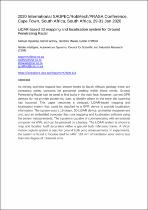JavaScript is disabled for your browser. Some features of this site may not work without it.
- ResearchSpace
- →
- Research Publications/Outputs
- →
- Conference Publications
- →
- View Item
| dc.contributor.author |
Ogunniyi, Samuel O

|
|
| dc.contributor.author |
Withey, Daniel J

|
|
| dc.contributor.author |
Marais, Stephen T

|
|
| dc.contributor.author |
Crafford, Gerhardus J

|
|
| dc.date.accessioned | 2020-09-14T18:43:45Z | |
| dc.date.available | 2020-09-14T18:43:45Z | |
| dc.date.issued | 2020-01 | |
| dc.identifier.citation | Ogunniyi, S.O., Withey, D.J., Marais, S.T. & Crafford, G.J. 2020. LiDAR-based 3D mapping and localisation system for Ground Penetrating Radar. In: 2020 International SAUPEC/RobMech/PRASA Conference, Cape Town, South Africa, South Africa, 29-31 Jan 2020 | en_US |
| dc.identifier.isbn | 978-1-7281-4162-6 | |
| dc.identifier.isbn | 978-1-7281-4163-3 | |
| dc.identifier.uri | https://ieeexplore.ieee.org/document/9041134 | |
| dc.identifier.uri | https://ieeexplore.ieee.org/xpl/conhome/9033509/proceeding | |
| dc.identifier.uri | http://hdl.handle.net/10204/11581 | |
| dc.description | Presented in: 2020 International SAUPEC/RobMech/PRASA Conference, Cape Town, South Africa, South Africa, 29-31 Jan 2020. Due to copyright restrictions, the attached PDF file contains the abstract of the full-text item. For access to the full-text item, please consult the publisher's website. | en_US |
| dc.description.abstract | As mining activities expand into deeper mines in South Africa's geology there are increasing safety concerns for personnel working within these mines. Ground Penetrating Radar can be used to find faults in the rock face; however, current GPR devices do not provide positioning data to identify where in the mine the scanning has occurred. This paper describes a compact, LiDAR-based mapping and localisation system that could be attached to a GPR device to provide localisation information. The system uses a 16-beam, 3D LiDAR device, an inertial measurement unit, and an embedded computer that runs mapping and localisation software using the sensor measurements. The system is capable of communicating with an external computer via WiFi, and can be powered by a battery. The LiDAR system is shown to map and localise itself accurately within a ground truth reference frame. A Vicon motion capture system is used for ground truth pose measurements. In experiments, the system is found to localise itself to within 101 mm of translation error and to less than one degree of rotational error. | en_US |
| dc.language.iso | en | en_US |
| dc.publisher | IEEE | en_US |
| dc.relation.ispartofseries | Workflow;23703 | |
| dc.subject | Ground Penetrating Radar | en_US |
| dc.subject | GPR | en_US |
| dc.subject | Iterative closest point | en_US |
| dc.subject | ICP | en_US |
| dc.subject | LiDAR | en_US |
| dc.subject | LiDAR Box | en_US |
| dc.subject | Mapping | en_US |
| dc.subject | Point Cloud Registration | en_US |
| dc.subject | Positioning | en_US |
| dc.subject | Vicon | en_US |
| dc.title | LiDAR-based 3D mapping and localisation system for Ground Penetrating Radar | en_US |
| dc.type | Conference Presentation | en_US |
| dc.identifier.apacitation | Ogunniyi, S. O., Withey, D. J., Marais, S. T., & Crafford, G. J. (2020). LiDAR-based 3D mapping and localisation system for Ground Penetrating Radar. IEEE. http://hdl.handle.net/10204/11581 | en_ZA |
| dc.identifier.chicagocitation | Ogunniyi, Samuel O, Daniel J Withey, Stephen T Marais, and Gerhardus J Crafford. "LiDAR-based 3D mapping and localisation system for Ground Penetrating Radar." (2020): http://hdl.handle.net/10204/11581 | en_ZA |
| dc.identifier.vancouvercitation | Ogunniyi SO, Withey DJ, Marais ST, Crafford GJ, LiDAR-based 3D mapping and localisation system for Ground Penetrating Radar; IEEE; 2020. http://hdl.handle.net/10204/11581 . | en_ZA |
| dc.identifier.ris | TY - Conference Presentation AU - Ogunniyi, Samuel O AU - Withey, Daniel J AU - Marais, Stephen T AU - Crafford, Gerhardus J AB - As mining activities expand into deeper mines in South Africa's geology there are increasing safety concerns for personnel working within these mines. Ground Penetrating Radar can be used to find faults in the rock face; however, current GPR devices do not provide positioning data to identify where in the mine the scanning has occurred. This paper describes a compact, LiDAR-based mapping and localisation system that could be attached to a GPR device to provide localisation information. The system uses a 16-beam, 3D LiDAR device, an inertial measurement unit, and an embedded computer that runs mapping and localisation software using the sensor measurements. The system is capable of communicating with an external computer via WiFi, and can be powered by a battery. The LiDAR system is shown to map and localise itself accurately within a ground truth reference frame. A Vicon motion capture system is used for ground truth pose measurements. In experiments, the system is found to localise itself to within 101 mm of translation error and to less than one degree of rotational error. DA - 2020-01 DB - ResearchSpace DP - CSIR KW - Ground Penetrating Radar KW - GPR KW - Iterative closest point KW - ICP KW - LiDAR KW - LiDAR Box KW - Mapping KW - Point Cloud Registration KW - Positioning KW - Vicon LK - https://researchspace.csir.co.za PY - 2020 SM - 978-1-7281-4162-6 SM - 978-1-7281-4163-3 T1 - LiDAR-based 3D mapping and localisation system for Ground Penetrating Radar TI - LiDAR-based 3D mapping and localisation system for Ground Penetrating Radar UR - http://hdl.handle.net/10204/11581 ER - | en_ZA |






